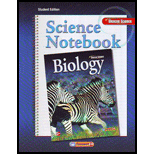
Concept explainers
To compare:
The given terms.
Introduction:
The study of the process that helps in the development of animals and plants is termed as developmental biology. In this section, regeneration, metamorphosis, asexual reproduction, and growth and differentiation of stem cells is studied.
Explanation of Solution
Cephalization is an evolution where the mouth, nerve ganglia, and sense organs are concentrated towards the front portion of the animal. This front region forms the head region.
Anterior is the portion towards the front of the body. For example, toes are anterior to the foot.
Posterior is the portion towards the back of the body. For example, shoulder blades are posterior to the sides of the body.
Ventral means the lower side of the body. For example, in fish, pectoral fins are ventral to dorsal fin.
Dorsal means location on he upper side of the body. For example, dorsal fin in fish.
Symmetry is the repetition of body parts of animals or plants in an order. Here, the parts are divided in the central point or axis.
In bilateral symmetry, the opposite sides of an organism are similar. The left portion is just same as right portion in sagittal plane. Humans have bilateral symmetry.
In circular symmetry, the regularity of parts is seen around the central axis. Jelly fish shows circular symmetry.
The group of animals in which the process of protostomy occurs is known as protostomes. Examples of protostomes are nematodes, mollusks, and
Deuterostomes are animals whose first opening is anus at the time of embryonic development.
Coelom is the main body cavity in various animals. It is found between the body wall and the intestinal canal.
The animal that does not have any body cavity is known as acoelomate. These animals lack fluid-filled cavity between the intestinal canal and the body wall.
The pseudocoelom is the fluid-filled cavity found in the nematode. It lies inside the external body wall and bathes the internal organs.
Additional Science Textbook Solutions
Genetic Analysis: An Integrated Approach (2nd Edition)
Biology: Life on Earth
Biology: Life on Earth (11th Edition)
 Human Anatomy & Physiology (11th Edition)BiologyISBN:9780134580999Author:Elaine N. Marieb, Katja N. HoehnPublisher:PEARSON
Human Anatomy & Physiology (11th Edition)BiologyISBN:9780134580999Author:Elaine N. Marieb, Katja N. HoehnPublisher:PEARSON Biology 2eBiologyISBN:9781947172517Author:Matthew Douglas, Jung Choi, Mary Ann ClarkPublisher:OpenStax
Biology 2eBiologyISBN:9781947172517Author:Matthew Douglas, Jung Choi, Mary Ann ClarkPublisher:OpenStax Anatomy & PhysiologyBiologyISBN:9781259398629Author:McKinley, Michael P., O'loughlin, Valerie Dean, Bidle, Theresa StouterPublisher:Mcgraw Hill Education,
Anatomy & PhysiologyBiologyISBN:9781259398629Author:McKinley, Michael P., O'loughlin, Valerie Dean, Bidle, Theresa StouterPublisher:Mcgraw Hill Education, Molecular Biology of the Cell (Sixth Edition)BiologyISBN:9780815344322Author:Bruce Alberts, Alexander D. Johnson, Julian Lewis, David Morgan, Martin Raff, Keith Roberts, Peter WalterPublisher:W. W. Norton & Company
Molecular Biology of the Cell (Sixth Edition)BiologyISBN:9780815344322Author:Bruce Alberts, Alexander D. Johnson, Julian Lewis, David Morgan, Martin Raff, Keith Roberts, Peter WalterPublisher:W. W. Norton & Company Laboratory Manual For Human Anatomy & PhysiologyBiologyISBN:9781260159363Author:Martin, Terry R., Prentice-craver, CynthiaPublisher:McGraw-Hill Publishing Co.
Laboratory Manual For Human Anatomy & PhysiologyBiologyISBN:9781260159363Author:Martin, Terry R., Prentice-craver, CynthiaPublisher:McGraw-Hill Publishing Co. Inquiry Into Life (16th Edition)BiologyISBN:9781260231700Author:Sylvia S. Mader, Michael WindelspechtPublisher:McGraw Hill Education
Inquiry Into Life (16th Edition)BiologyISBN:9781260231700Author:Sylvia S. Mader, Michael WindelspechtPublisher:McGraw Hill Education





